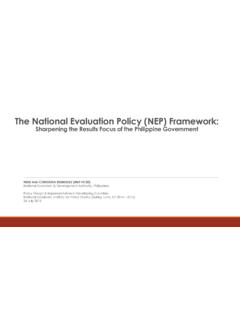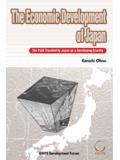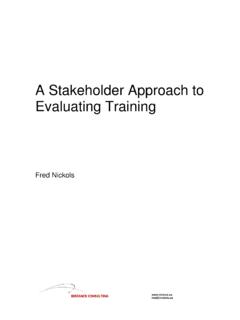Transcription of Macroeconomic Policy Analysis of Vietnam
1 Macroeconomic Policy Analysis of Vietnam A Macro-Econometric model Approach Le Anh Minh PhD Student Nagoya University Graduate School of International Development Abstract Since 1986, Vietnam has been implementing its transition from centrally planned economy to a market economy and has maintained an opening-up Policy . Economic reforms on both demand side and supply side have largely contributed to successes of the economy. Since 1990, the economic development has been impressive, even if Vietnam was strongly affected by the Asian financial crisis in 1997-1998. The high economic growth was achieved in a stable Macroeconomic situation. Inflation was kept within a controllable range. As a consequence of its integration into the world economy and its economic reforms, Vietnam has benefited from inflows of foreign direct investment (FDI) and foreign exchange expansion.
2 Undoubtedly, the Macroeconomic policies have played an important role in stabilizing the economy in this period. However the slowdown of economic growth during the Asian crisis has raised the need for suitable adjustments in economic policies to speed up the economic development. The objective of this paper is to analyze the impacts of short-term Macroeconomic Policy s adjustments in Vietnam . These impacts are investigated by employed a macro-econometric model with the assumption of demand determined economy in the short term. Based on the characteristics of transition period, Vietnamese economy s model is constructed and adjustments of fiscal Policy and exchange rate Policy are analyzed since 1998, when Vietnamese economic growth has been slowing down. Fiscal relaxation and exchange rate devaluation are two main policies which is suggested for promoting growth in this period.
3 Introduction As demand management policies, Macroeconomic policies have short-run effects through the changes in aggregate demand and prices. Cook and Kirkpatrick (1990) report that the objective of Macroeconomic policies is to control the short-run behavior of an economy. The behavior is monitored by the movements in the three main aggregate level variables the output level, the inflation rate and the balance of payment. In general, for internal balance, the policies raising aggregate demand in the short term will lead to increase in the 1output and price level. For an open economy, external balance is affected by changes in domestic interest rate and exchange rate. It has been evident that Macroeconomic policies in Vietnam have contributed much to the success of the country after Renovation Policy , especially over the last decade. As a result, the Vietnamese economy has made many significant achievements over more than 15 years of Renovation.
4 In the last decade, the country enjoyed very promising economic performance. High economic growth was achieved in a stable economy and GDP doubled after 10 Inflation has been curbed. Open door economic Policy resulted in huge external financial inflows in the forms of Foreign Direct Investment (FDI) and Official Development Assistance (ODA), and strong external trade growth. However, the slowdown in economic growth in some recent years has raised the need for suitable adjustments in economic management. In 1997-1998, the Asian economic crisis resulted in decline in exports and capital inflows of Vietnam . Domestic prices have been kept stable, but there have been some signs of stagnant domestic demand. Despite high economic growth rate gained in the last period, there is still a big gap in development level between the country and the region. For the future of Vietnamese economic development, it is necessary to keep a stable high economic growth rate.
5 The Vietnamese economy in transition period has been an attractive topic involving numerous studies. However quantified Analysis of policies impact on the economy has been limited. The main reason is that the transformation period from centrally planned economy to market economy has taken place for only a short period, and thus the necessary data for such study is limited. It is difficult but interesting to carry out quantitative Analysis of the Vietnamese economy. The main objective of this paper is to analyze impacts of Macroeconomic policies adjustments on the Vietnamese economy in the transition period. For the purpose of quantitative Analysis , macro-econometric models can take into account macro behavioral relationships and are suitable for analyzing medium term and short term impacts of Macroeconomic policies. With the given objective of study, macro-econometric modeling will be used as a method of quantitative Analysis .
6 Data collecting for model is always difficult when applying quantitative study method for Vietnamese economy. In order to build a macro econometric model , Macroeconomic time series data is collected from national account in the period 1986 to 2003. Other necessity necessary data is collect from other sources of Vietnamese government, ADB, WB and IMF. 1 In terms of 1994 constant price, GDP in 1990 was VND 131,968 billion and in the year 2000 was VND 273,666 billion VND. 2 The structure of this article is as follow: In the section 1, an introduction about the background, also the objective and methodology of the study in this paper is given. Section 2 overviews the Vietnamese economy performance and Macroeconomic policies implementation after Renovation program. Section 3 is employed to build a macro econometric model based on characteristics of the economy.
7 Section 4 evaluates the impacts of Macroeconomic Policy adjustment. Two scenarios of fiscal Policy relaxation and exchange rate devaluation implementation are considered. In the section 5, conclusions are drawn based on the results and suggestions for Policy implications. 1. VIETNAMESE ECONOMIC PERFORMANCE AND Macroeconomic Policy AFTER RENOVATION Policy Macroeconomic performance after renovation Policy Vietnamese economy has been in a transition period since 1986, transforming from a centrally planned economy to market economy under the Doimoi or Renovation program. Although the Doimoi program was initiated in 1986, only in the spring 1989 did Vietnam embark on comprehensive reform towards a market economy. The reform aimed to stabilize the economy, remove administrative controls that stifled economic performance, and induce market development.
8 The stabilization program was adopted in 1989 as a combination of reforms. The key components of the program were tight monetary and fiscal policies and an appropriate exchange rate Policy . The reform included devaluating and unifying the market exchange rates, raising nominal interest rates and thereby pushing real rates to positive levels, reducing subsidies to SOEs, curbing public sector expenditures, restraining increases in wages and state-run sector and state budget expenditures as well as halting the financing of state budget deficits by printing money. A new banking system was established to replace the old mono banking system with a two level banking system that separated the functions of management carried out by state bank from business activities of commercial banks. A new taxation system was also established in this period. A series of tax laws was promulgated including turnover tax, profit tax, export and import taxes.
9 The new tax system contributed to the increase in fiscal revenue and Macroeconomic stabilization. Price liberalization was carried out in the period 1989-1991. In the meantime, supply side related policies such as encouraging the development of a multi-ownership economy, restructuring of SOEs, decollectivizing and granting individuals and families long-term user rights to productive land in the agricultural sector were essential factors included in the reform package. In the 1990s, particularly the first half, the economy showed very good performance. High economic growth was attained under stable Macroeconomic conditions. As a result of a stabilization program, hyper inflation was curbed. 3 Table Vietnam : Some Macroeconomic Indicators (1990-2003) 1990 1991 1992 1993 1994 1995 1996 1997 1998 1999 2000 2001 2002 2003 GDP growth (%) Agriculture growth (%) Industry growth (%)
10 Services growth (%) Unemployment rate in cities (%) CPI index (1994=100) Inflation rate (%) FDI (implemented) (USD.)










